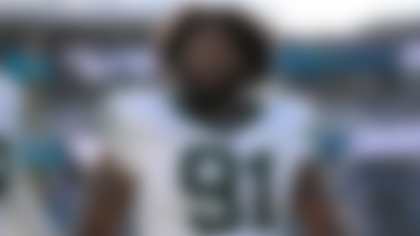How valuable is a franchise quarterback?
Hall of Fame coach Vince Lombardi used to tell his cronies that football is the perfect team sport with the exception of one glaring imbalance -- the quarterback is too important.
It's no secret that sustained NFL success correlates to steady quarterback performance. We witnessed the flip side of that truism Thursday night in the first round of the 2017 NFL Draft.
When organizations struggle to find relevancy at professional sports' most influential position, their exhaustive quarterback searches deplete resources otherwise spent stockpiling young talent.
Less than two months after handing Mike Glennon$18.5 million in guarantees, the Bearssurrendered three extra draft picks to vault one spot over the 49ers for North Carolina's Mitchell Trubisky, a quarterback with 13 college starts.
After watching Tony Romo choose the broadcast booth over the AFC South, the Texansrelinquished next year's first-round pick to move into the Browns' No. 12 spot for Clemson's Deshaun Watson. That bold maneuver came in response to last month's decision to flip their 2018 second-round pick to the same Cleveland franchise willing to take Brock Osweiler's bloated salary off of Houston's hands.
Whereas the Bears and Texans entered the offseason with a mandate to find a solution under center, Alex Smith has led Kansas City to the NFL's best winning percentage (.793) since the middle of the 2015 season.
Tacitly acknowledging Smith's limitations in the face of season-ending playoff losses to the Patriots and Steelers the past two years, coach Andy Reid identified Texas Tech's Patrick Mahomes as the quarterback of the future. The Chiefs gave up this year's third-round pick and next year's first-round pick for a gifted developmental prospect who can sit for a year before pushing Smith in 2018.
This year's quarterback class came billed as a raw but talented group noticeably lacking can't-miss prospects and NFL-ready starters. That didn't stop three desperate teams from depleting valuable draft resources to roll the dice on their potential.
Here's what else we learned in the first round of the 2017 NFL Draft:
- The Browns might not have fixed their own long-standing quarterback woes, but they did well to add three potential stars in defensive end Myles Garrett (No. 1), versatile defensive back Jabrill Peppers (No. 25) and freakishly athletic tight end David Njoku (No. 29). It's fair to second-guess Cleveland for bypassing Carson Wentz a year ago, but we have no issue with the decision to address other positions of need rather than reaching for a signal-caller in this year's underwhelming QB class.
- We've heard for months that this was one of the weakest collections of offensive-line prospects in recent memory. That played out Thursday night, as this year's draft is the first since 1982 without an offensive tackle selected in the top 15 slots. Per NFL Research, it is also the first draft of the common draft era (1967) in which no offensive linemen were selected in the top 15. Utah tackle Garrett Bolles (Broncos, No. 20) and Wisconsin tackle Ryan Ramczyk (Saints, No. 32) were the only two offensive linemen drafted Thursday night.
- While the offensive line went according to script, the same can't be said of the so-called skill positions. In a draft loaded with impact defensive talent, five of the top nine picks were running backs and wide receivers. The playmaking ability of Leonard Fournette and Christian McCaffrey was too tempting to pass up in the backfield. The Titans, Chargers and Bengals deemed the dropoff at wideout steep enough to gobble up the top three prospects rather than addressing the defense with top-10 picks.
- Is the NFL growing skeptical of Alabama standouts? Defensive tackle Jonathan Allen (No. 17), tight end O.J. Howard (No. 19), linebacker Reuben Foster (No. 31) and offensive tackle Cam Robinson all suffered precipitous slides from where they were projected in the mock-draft community.
- Kudos to the new 49ers tandem of John Lynch and Kyle Shanahan for landing a pair of special talents in Foster and defensive end Solomon Thomas (No. 3), while also picking up extra mid-round picks from the Bears. San Francisco's reconstructed defense will feature three top-10 picks on the defensive line to go with a sideline-to-sideline thumper who drew pre-draft comparisons to 49ers legend Patrick Willis.
- If the Niners' defense isn't the league's most improved this year, that honor might go to the Colts. On the heels of a productive free agency period that brought a revamped front seven, new general manager Chris Ballard lucked into rangy Ohio State safety Malik Hooker at No. 15 overall. Coach Chuck Pagano has long needed a centerfielder to anchor the back end of his defense. Now he has a future star who will remind him of close friend Ed Reed:
- If San Francisco and Indianapolis deserve acclaim for their work on defense, the Buccaneers and Giants should be vying for best offensive overhaul. After stealing deep threat DeSean Jackson from the Redskins, Tampa Bay landed Howard (No. 19) to pair with the underrated Cameron Brate at tight end. After signing Brandon Marshall to complement Odell Beckham and Sterling Shepard at wide receiver, the G-Men added another new toy in athletic tight end Evan Engram (No. 23). Jameis Winston is poised for a breakout season, while Eli Manning has no excuse not to bounce back from last year's disappointing showing.












